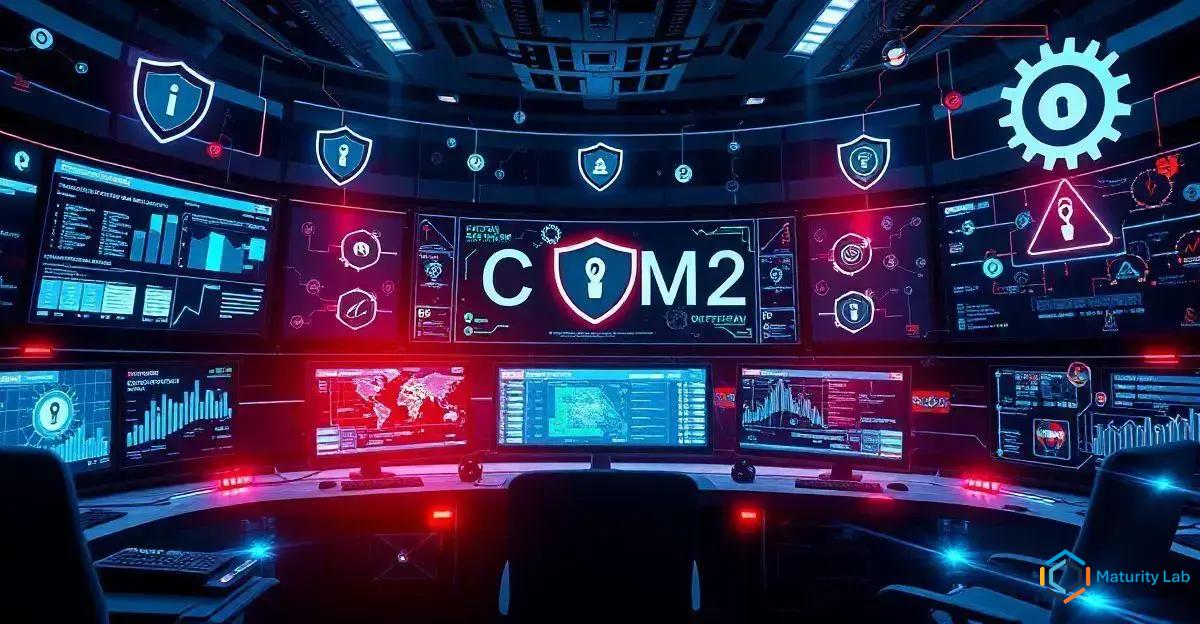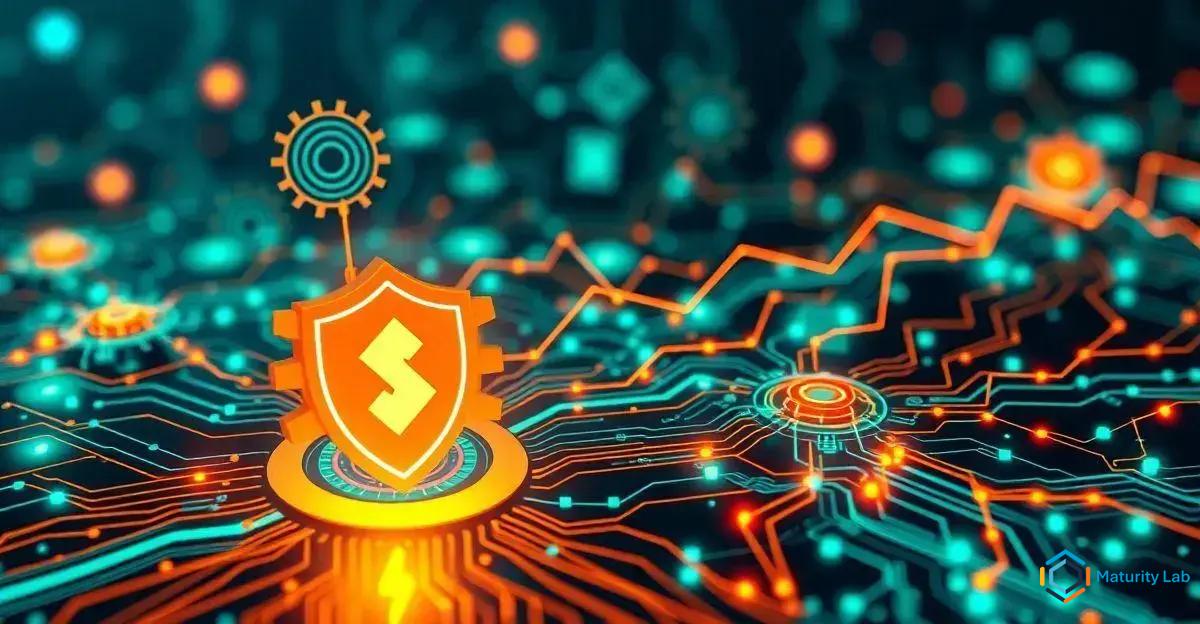The Cybersecurity Capability Maturity Model (C2M2) is a structured framework aimed at improving an organization’s cybersecurity by evaluating and enhancing its protection and incident response capabilities across ten domains, including Risk Management and Incident Management. It provides essential guidelines for access control, data protection, and network security, while highlighting the necessity of a defined incident response plan and ongoing improvement to combat evolving threats, making it suitable for organizations of all sizes to align cybersecurity with business goals like regulatory compliance.
In today’s rapidly evolving digital landscape, organizations must prioritize robust protection capabilities and efficient incident response mechanisms. The Cybersecurity Capability Maturity Model (C2M2) offers a structured approach to enhancing these critical areas. By leveraging C2M2, businesses can systematically assess and improve their cybersecurity practices, ensuring resilience against emerging threats. This article delves into the intricacies of the C2M2 framework, exploring how it can be utilized to bolster protection capabilities and streamline incident response efforts.
Understanding the C2M2 Framework

The Cybersecurity Capability Maturity Model (C2M2) is a comprehensive framework designed to enhance the cybersecurity posture of organizations across various sectors. Developed by the U.S. Department of Energy, C2M2 provides a structured methodology for assessing and improving cybersecurity capabilities. The framework is particularly valuable for organizations seeking to systematically identify weaknesses, prioritize improvements, and track progress over time.
C2M2 is built upon ten domains, each representing a critical aspect of cybersecurity. These domains include Risk Management, Asset Management, and Incident Management, among others. By evaluating an organization’s maturity across these domains, C2M2 helps to create a holistic view of its cybersecurity capabilities. This structured approach ensures that all relevant areas are addressed, reducing the likelihood of overlooked vulnerabilities.
One of the key strengths of the C2M2 framework is its scalability. It is designed to be applicable to organizations of varying sizes and complexities, from small businesses to large enterprises. This flexibility allows for tailored assessments that reflect the unique needs and contexts of different organizations. Additionally, C2M2 emphasizes continuous improvement, encouraging organizations to regularly revisit and refine their cybersecurity practices.
The Maturity Model
The framework employs a maturity model that ranges from Level 1 (Initial) to Level 5 (Optimizing). At Level 1, cybersecurity practices are typically ad hoc and reactive, with limited formalization. As organizations progress through the levels, their practices become increasingly proactive, documented, and optimized. This progression not only enhances cybersecurity resilience but also aligns with broader business objectives, such as regulatory compliance and risk management.
To effectively implement C2M2, organizations should begin with a thorough self-assessment. This involves evaluating current practices against the framework’s criteria and identifying areas for improvement. Following the assessment, organizations can develop a targeted action plan to address identified gaps and enhance their cybersecurity maturity. Wouldn’t it be more efficient to implement an action plan to enhance your company’s maturity after understanding its current maturity level?
In summary, the C2M2 framework offers a robust and flexible approach to enhancing cybersecurity capabilities. By understanding and applying its principles, organizations can systematically improve their protection capabilities and incident response mechanisms, ultimately achieving a higher level of cybersecurity maturity.
Enhancing Protection Capability with C2M2

Enhancing protection capability is a critical objective for any organization aiming to safeguard its digital assets and maintain operational continuity. The Cybersecurity Capability Maturity Model (C2M2) provides a structured approach to achieving this goal by offering a detailed framework for assessing and improving protection mechanisms.
Within the C2M2 framework, the Protection Domain focuses on the measures and controls that organizations must implement to defend against cyber threats. This domain encompasses a range of activities, including access control, data protection, and network security. By systematically evaluating these areas, organizations can identify weaknesses and implement targeted improvements to bolster their protection capabilities.
One of the key components of enhancing protection capability with C2M2 is the implementation of robust access control measures. This involves ensuring that only authorized individuals have access to critical systems and data. Techniques such as multi-factor authentication (MFA) and role-based access control (RBAC) are essential in mitigating unauthorized access risks. C2M2 guides organizations in assessing the maturity of their access control practices and identifying areas for enhancement.
Data protection is another critical aspect addressed within the C2M2 framework. Organizations must implement measures to ensure the confidentiality, integrity, and availability of their data. This includes encryption, regular data backups, and secure data storage solutions. By following the C2M2 guidelines, organizations can systematically evaluate their data protection practices and implement improvements to safeguard sensitive information.
Network security is also a vital component of the Protection Domain. Organizations must deploy measures to secure their network infrastructure, including firewalls, intrusion detection systems (IDS), and regular network monitoring. C2M2 provides a structured approach to assessing the maturity of network security practices and identifying opportunities for enhancement. This ensures that organizations can effectively defend against network-based threats and maintain a secure operational environment.
The C2M2 framework emphasizes the importance of continuous improvement in protection capability. Organizations are encouraged to regularly review and update their protection measures in response to evolving threats and technological advancements. This proactive approach ensures that protection capabilities remain robust and effective over time.
In conclusion, enhancing protection capability with C2M2 involves a comprehensive evaluation of access control, data protection, and network security practices. By following the framework’s guidelines, organizations can systematically identify and address weaknesses, ultimately achieving a higher level of cybersecurity maturity. Wouldn’t it be prudent to leverage a structured framework like C2M2 to ensure your organization’s protection capabilities are always at their best?
Optimizing Incident Response through C2M2

Incident response is a critical component of an organization’s cybersecurity strategy, ensuring that threats are swiftly identified, contained, and mitigated.
The Cybersecurity Capability Maturity Model (C2M2) offers a structured approach to optimizing incident response capabilities, helping organizations to develop and refine their processes to handle cybersecurity incidents effectively.
The Incident Management Domain within the C2M2 framework focuses on the procedures and protocols that organizations must establish to respond to cybersecurity incidents. This includes incident detection, analysis, containment, eradication, and recovery. By systematically evaluating these areas, organizations can identify gaps and implement targeted improvements to enhance their incident response capabilities.
One of the foundational elements of optimizing incident response with C2M2 is the establishment of a well-defined incident response plan. This plan should outline the roles and responsibilities of the incident response team, the procedures for detecting and reporting incidents, and the steps for containing and mitigating threats. C2M2 provides guidelines for assessing the maturity of an organization’s incident response plan and identifying areas for enhancement.
Effective incident detection is another critical aspect addressed within the C2M2 framework. Organizations must implement measures to promptly identify potential security incidents. This includes deploying advanced monitoring tools, conducting regular security assessments, and maintaining situational awareness. By following the C2M2 guidelines, organizations can systematically evaluate their incident detection capabilities and implement improvements to ensure timely identification of threats.
Incident analysis and containment are also vital components of the Incident Management Domain. Organizations must have procedures in place to analyze the nature and scope of incidents and to contain them to prevent further damage. This involves utilizing forensic tools, conducting thorough investigations, and implementing containment strategies. C2M2 provides a structured approach to assessing the maturity of these practices and identifying opportunities for enhancement.
Recovery and post-incident analysis are essential for ensuring that organizations can quickly resume normal operations and learn from past incidents. This includes restoring affected systems, conducting root cause analysis, and implementing corrective actions to prevent recurrence. The C2M2 framework emphasizes the importance of continuous improvement in incident response, encouraging organizations to regularly review and update their processes in response to evolving threats.
In summary, optimizing incident response through C2M2 involves a comprehensive evaluation of incident detection, analysis, containment, and recovery practices. By following the framework’s guidelines, organizations can systematically identify and address weaknesses, ultimately achieving a higher level of cybersecurity maturity. Wouldn’t it be advantageous to leverage a structured framework like C2M2 to ensure your organization’s incident response capabilities are always at their peak?
In conclusion, the Cybersecurity Capability Maturity Model (C2M2) provides a robust and flexible framework for enhancing an organization’s cybersecurity posture.
By systematically assessing and improving protection capabilities and incident response mechanisms, C2M2 enables organizations to achieve a higher level of cybersecurity maturity. The framework’s structured approach ensures that all critical areas, including access control, data protection, network security, and incident management, are thoroughly evaluated and optimized.
Understanding the C2M2 framework is the first step toward leveraging its benefits. By comprehensively evaluating an organization’s cybersecurity practices across its ten domains, C2M2 helps to create a holistic view of its strengths and weaknesses. This structured methodology facilitates targeted improvements, ensuring that protection capabilities are robust and incident response mechanisms are efficient.
Enhancing Protection Capability
Enhancing protection capability with C2M2 involves implementing robust access control measures, ensuring data protection, and securing network infrastructure. The framework’s guidelines provide a clear path for organizations to systematically identify and address weaknesses, ultimately achieving a higher level of resilience against cyber threats.
Optimizing Incident Response
Optimizing incident response through C2M2 requires a well-defined incident response plan, effective incident detection, thorough analysis and containment procedures, and efficient recovery processes. By following the C2M2 guidelines, organizations can ensure that their incident response capabilities are always at their peak, enabling them to swiftly and effectively handle cybersecurity incidents.
Ultimately, the C2M2 framework emphasizes continuous improvement, encouraging organizations to regularly review and update their cybersecurity practices in response to evolving threats and technological advancements. By leveraging C2M2, organizations can not only enhance their protection capabilities and incident response mechanisms but also align their cybersecurity efforts with broader business objectives, such as regulatory compliance and risk management.
Wouldn’t it be more efficient to implement an action plan to enhance your company’s maturity after understanding its current maturity level? By adopting the C2M2 framework, organizations can systematically improve their cybersecurity posture, ensuring resilience and preparedness in the face of emerging threats.
Frequently Asked Questions about C2M2, Protection Capability, and Incident Response
What is the Cybersecurity Capability Maturity Model (C2M2)?
The Cybersecurity Capability Maturity Model (C2M2) is a comprehensive framework developed by the U.S. Department of Energy to help organizations assess and improve their cybersecurity capabilities. It covers ten domains, including Risk Management, Asset Management, and Incident Management, and provides a structured methodology for identifying weaknesses and prioritizing improvements.
How does C2M2 enhance protection capability?
C2M2 enhances protection capability by providing guidelines for implementing robust access control measures, ensuring data protection, and securing network infrastructure. By systematically evaluating these areas, organizations can identify weaknesses and implement targeted improvements to bolster their protection capabilities.
What are the key components of an effective incident response plan according to C2M2?
An effective incident response plan according to C2M2 should outline the roles and responsibilities of the incident response team, procedures for detecting and reporting incidents, and steps for containing and mitigating threats. It should also include measures for recovery and post-incident analysis to ensure continuous improvement.
How does C2M2 help in optimizing incident response?
C2M2 helps in optimizing incident response by providing a structured approach to evaluating and improving incident detection, analysis, containment, and recovery practices. By following the framework’s guidelines, organizations can ensure that their incident response capabilities are efficient and effective.
Why is continuous improvement important in the C2M2 framework?
Continuous improvement is important in the C2M2 framework because it ensures that an organization’s cybersecurity practices remain robust and effective in the face of evolving threats and technological advancements. Regularly reviewing and updating practices helps maintain a high level of cybersecurity maturity.
Can C2M2 be applied to organizations of all sizes?
Yes, C2M2 is designed to be scalable and applicable to organizations of varying sizes and complexities. Its flexibility allows for tailored assessments that reflect the unique needs and contexts of different organizations, from small businesses to large enterprises.

